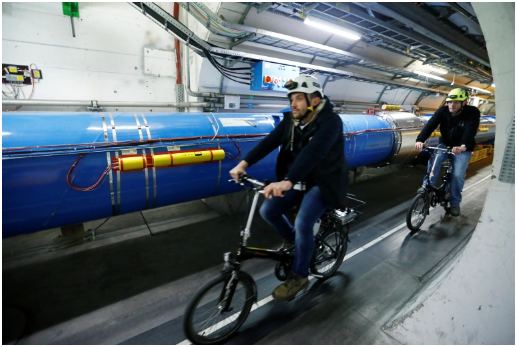Scientists in Switzerland have resumed smashing together the tiny particles that make up the physical properties of the universe, in hopes of better understanding the forces and phenomena that undergird existence.
On Tuesday, the latest round of experiments began at the Large Hadron Collider, a massive apparatus at the European Organization for Nuclear Research (CERN) facility in Geneva, following a three-year renovation that scientists say has upped the possibilities for the world’s largest and most powerful particle accelerator.
The beginning of the so-called “Run 3” of the collider comes nearly a decade after data it yielded proved the existence of the Higgs boson particle, also known as the “God particle”, a revelatory discovery that scientists say confirmed the “final puzzle piece” of the Standard Model theory, which outlines the fundamental building blocks and forces of the universe.

What is the Large Hadron Collider?
At its most basic, the Large Hadron Collider (LHC) is a mechanism that creates controlled beams of atomic and subatomic particles, which are then made to collide. Using extremely advanced sensors, data can be collected and studied from the collisions, which can briefly reveal the even smaller particles that make up those that collided. The collision process has been used to create what has been described as a mini-big bang, helping to shed light on the conditions in the first moments of the creation of the universe.
The LHC consists of a 27km underground ring of “superconducting magnets” and energy-boosting structures that help the particle beams travel at the near speed of light. The ring is connected to a distribution system of liquid helium, which keeps the magnets at ‑271.3 degrees celsius, a temperature colder than space, according to CERN.
The collider, which took about three decades to plan and build, began operating on September 10, 2008. It was shut down in 2013 and 2018 for upgrades. The current experiment will involve collisions at a record 13.6 trillion electronvolts, allowing for increased collision rates and higher collision energy.
“This is a significant increase, paving the way for new discoveries,” CERN Director for Accelerators and Technology Mike Lamont said in a statement.
The collider began running in April to rev up to the level needed to conduct the experiments.
What has been discovered before?
The most high-profile discovery from the collider has been the confirmation of the existence of the Higgs boson, a sub-atomic particle that “essentially provides the origin of mass”, Brian Cole, a professor of experimental nuclear physics at Columbia University, told Al Jazeera at the time of the discovery.
Mass is one of the most basic properties of matter, which makes up all physical components of the universe. Because of this, the Higgs boson particle has already helped scientists to explain several phenomena, including how atoms have mass.
It could also help to reveal details of how the universe formed.
“We know that very early in the universe, a period of what’s called inflation occurred, when the universe grew incredibly rapidly over billionths of a billionths of a second,” Cole said. “And we don’t yet know quite how that happened, but it’s possible that had to do with the Higgs.”
The existence of the Higgs boson was first theorised by a group of scientists, including Peter Higgs, a physicist at the University of Edinburgh, in 1964, almost 50 years before it was proven.
The collider has been used to discover dozens more so-called “non-elementary” particles, meaning particles beyond the protons, neutrons, and electrons that make up an atom.
What are scientists hoping to find?
Scientists will seek to further study the Higgs boson, with the updated collider allowing for a better understanding of the behaviour of the particle.
Scientists also hope the advanced technology will help to detect signs of dark matter, which is matter that cannot be seen directly, but is known to exist because of its effect on observable objects, including its gravitational pull, according to the United States space agency NASA.
There is also hope that the LHC will help to answer the question of why there is considerably less antimatter in the universe compared to its partner substance, matter, when both should have been produced in equal parts following the big bang.
Meanwhile, as experiments got under way on Tuesday, scientists at CERN announced the discovery of new “exotic particles” that could provide clues about the force that binds subatomic particles together.







